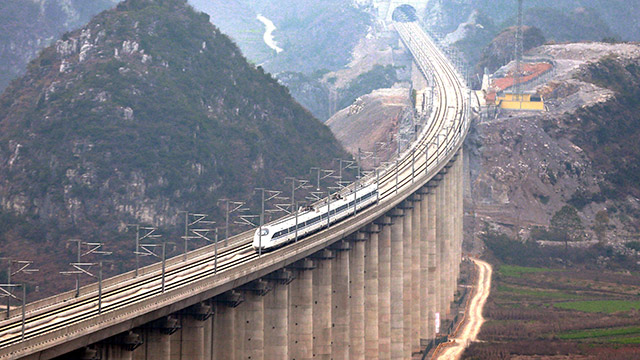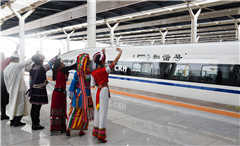Bullet train network still moving at speed
2017-01-06
China Daily
 A train crosses a bridge in Guizhou province on Dec 29, the first day of operations for the Kunming-Guiyang high-speed railway.[Photo/China Daily]
A train crosses a bridge in Guizhou province on Dec 29, the first day of operations for the Kunming-Guiyang high-speed railway.[Photo/China Daily]
The opening of two high-speed rail lines on Dec 28 and the start of work on a new line the following day signaled that China’s high-speed rail construction program continues to move forward at a rapid pace.
Last year, four major high-speed lines were opened, bringing the total distance covered by the nation’s high-speed rail network to more than 22,000 km, accounting for 60 percent of the high-speed rail networks around the world, according to China Railways Corp, the national rail operator.
The four lines are: the Zhengzhou-Xuzhou railway connecting central and East China; the Chongqing-Wan-zhou railway, the first high-speed railway to enter the Three Gorges area; the Kunming-Guiyang railway which links Shanghai and Kunming; and the Kunming-Baise railway, connecting Kunming and Guangzhou.
Of the four, the newest, the Kunming-Guiyang railway, is part of the Shanghai-Kunming line, and at 2,252 kilometers it is the longest of China’s east-west rail lines.
“High-speed rail continued its stable and steady development in 2016, the first year of the 13th Five-Year Plan (2016-20). The most significant moment was the opening of the Shanghai-Kunming rail line as a passage to link east and west,” said Yang Hao, a professor of rail transportation management at Beijing Jiaotong University.
“Only two sections of the north-south and east-west high-speed railway grid have not yet opened-the lines between Jinan and Shijiazhuang and between Baoji and Lanzhou. At the current rate of progress, we expect to fulfill our target before 2020, much earlier than scheduled” he said.
Quality of operations
The high-speed grid of four north-south lines and four east-west lines is on course to meet a 2008 target to complete the work by 2020.
“The highlight of the year was that the high-speed rail grid, with four north-south lines and four east-west lines, is taking shape,” said Yu Zhanfu, principal of the Beijing office of Roland Berger Strategy Consultants. “In addition to opening more lines, the high quality of operations, such as the punctuality of departures and arrivals, is very impressive.”
Last year, nearly 99 percent of bullet trains departed on time and more than 95 percent arrived on time, according to the CRC.
In July, two Chinese-designed bullet trains passed in opposite directions at world-record speeds of 420 km/h during a test run conducted by the corporation.
“The success of the test demonstrates that China has mastered comprehensive knowledge of the bullet train’s core technologies,” said Zhou Li, director of the CRC’s science and technology administration department. “It also shows that China’s high-speed train technology ranks among the most advanced in the world, and even leads the world in some technologies.”
The test measured the trains’ performance, particularly the traction, braking and software systems, which all employ Chinese technology.
In addition to setting a technological record, the number of passengers hit a record high in August.
The corporation’s trains have carried about 5 billion passengers since 2008, and the number of people using the high-speed network has risen by 30 percent every year.
Last year, more than 1.4 billion trips were made on China’s bullet trains, accounting for more than 52 percent of total passenger numbers, according to CRC data
On Dec 29, Yang Yudong, head of the National Railway Administration, told a media briefing that during the period of the 13th Five-Year Plan, China will invest 3.5 trillion yuan ($503 billion) to expand the railway network and accelerate development, and by 2020, high-speed rail lines will stretch 30,000 km as part of a final targeted network of 150,000 km.
In July, the National Development and Reform Commission, the nation’s top economic planner, issued an updated national railway development plan that envisions a 175,000-km rail network by the end of 2025, by which time the country will have 38,000 km of high-speed track, according to the plan. Moreover, by 2030, the nation’s rail network will expand to nearly 200,000 km, including 45,000 km of high-speed lines.
“We will accelerate the construction of railways in China’s central and western regions, and we will also boost the expansion of intercity and suburban rail links,” said Zhang Dawei, deputy head of the Ministry of Transport’s planning department. “By the end of 2020, more than 80 percent of mainland cities with populations of at least 1 million will be served by high-speed railways.”
Continuous development
Yu, from Roland Berger, urged continuous development of the network: “The country’s top planners must ensure that the work (planned in 2008) is mostly done, and then release a new plan.”
China will continue to expand the rail network in the future, according to Yu. “In the more economically developed regions, such as the eastern and southern coastal areas, we have already seen the high-speed rail industry transformed into a powerful economic driving force. But in less-developed areas, such as central and western regions, it will take time to see the (financial) returns from high-speed rail lines,” he said.
Yang from Beijing Jiaotong University, said the decision to expand the high-speed network was a wise one: “Once a line has been built, it can be used for years. From a long-term perspective, it is not possible to just build high-speed rail lines in the eastern regions. Balance is important in development.”
In October, 61-year-old Lu Dongfu was appointed as the CRC’s new general manager, replacing 67-year-old Sheng Guangzu, who was China’s last minister of railways before rail operations were handed over to the corporation.



